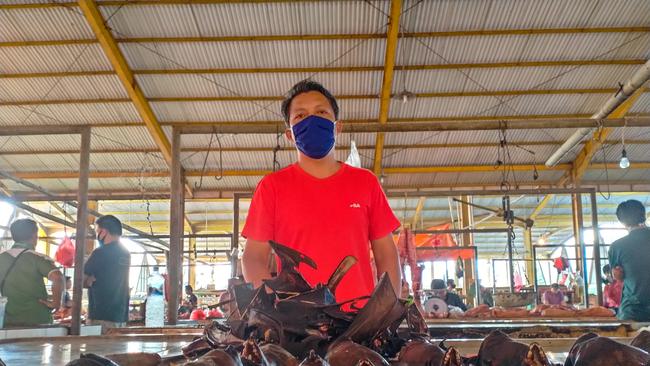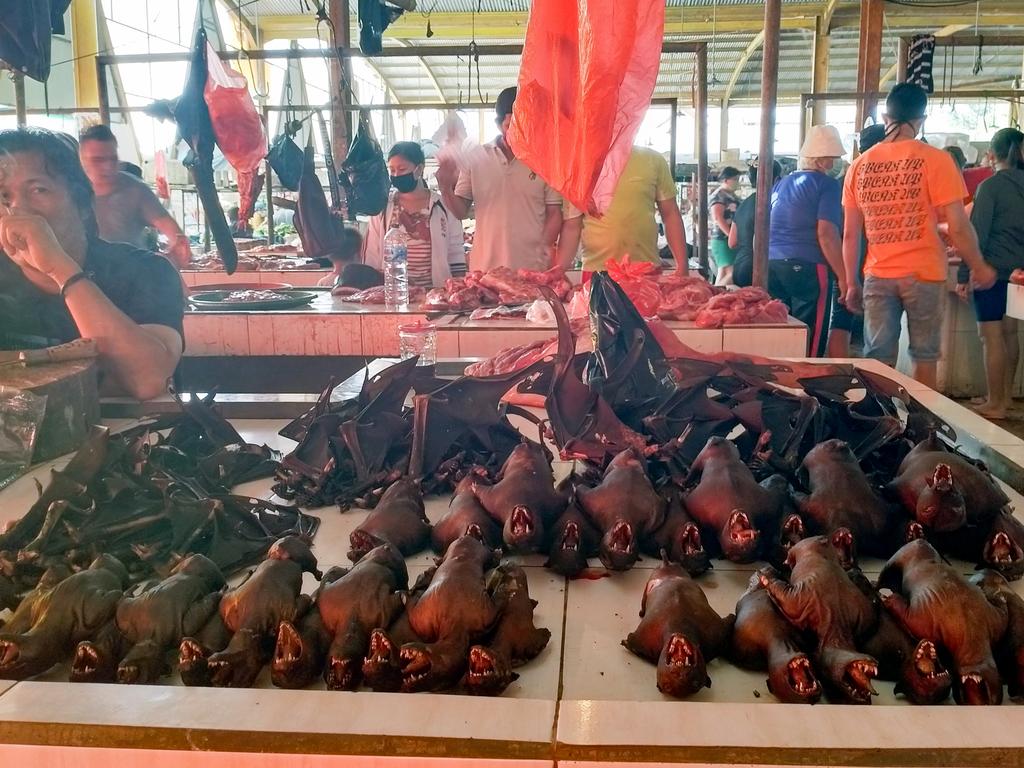Coronavirus: Bats have evolved into perfect virus carriers
If COVID-19 didn’t escape from a Chinese government lab in Wuhan, as most scientists believe, the skies hold the answer.

If COVID-19 didn’t escape from a Chinese government lab in Wuhan, as most scientists believe, how did the pandemic start?
Look to the evening sky and you might see the answer flit by in an inky blur: the bat is central to understanding the disastrous progression of the disease to people, and will loom large in planning to stop it happening again.
The surprise is that the world actually seemed surprised by the emergence of the new coronavirus. There is nothing new to this story. The transmission path of a pathogen that incubated in a bat, gained potency in an intermediate animal host and broke into the human population is well charted. Think severe acute respiratory syndrome, Middle East respiratory syndrome, Australia’s Hendra virus and its Asian cousin Nipah, the paramyxovirus featured in the chilling movie Contagion.
Bats also carry but don’t necessarily transmit Ebola and Marburg virus in equatorial Africa. They can impart Australian bat lyssavirus direct to people, a form of rabies that is fatal once it takes hold. Still, it would be a mistake to see the winged creatures as the villain of the piece, especially in this country. Bats are the epic pollinators of a wide, brown land. Without them the eucalypt forests would never bloom, the koala would be dead as a dodo.
In a way, the pandemic threat would be easier to manage if it turned out the conspiracy theories swirling around the Wuhan Institute for Virology had legs and the Chinese were to blame. The evidence is tenuous, to say the least. True, the high-containment laboratory is around the corner from the now notorious Wuhan seafood and live-animal market that may or may not have been the ignition point for the outbreak but that was certainly integral to its early spread through the industrial city of 11 million.
And there are the alarming cables sent to Washington by American diplomats who visited the facility in March 2018, warning of safety and management deficiencies. They met, among others, the head of the institute’s bat coronavirus project, Shi Zhengli. Renowned as China’s “bat woman”, she had published important research showing that horseshoe bats from a cave in remote Yunnan province were likely from the same bat population that gave rise to the SARS coronavirus in 2002.
More important, Shi’s team demonstrated that several SARS-like coronaviruses could interact with the human receptor identified for SARS-coronaviruses, ACE2, “strongly suggesting” that coronaviruses from bats could be transmitted to people to cause SARS-like diseases, according to the cables, obtained by The Washington Post. This represented a risk of a “new SARS-like pandemic”.
Shi, as it happens, had three months in Australia in 2006 on exchange at the CSIRO’s advanced Australian Animal Health Laboratory where another senior bat scientist from the institute, Peng Zhou, also spent time. Sydney’s Daily Telegraph played up the angle when it reported this week that the work of both researchers was being examined by the Five Eyes network of spy agencies in Australia, the US, Britain, New Zealand and Canada investigating whether the virus had somehow got out of the lab.
The paper, however, shot down its own story by revealing that an Australian intelligence assessment initially rating the probability of a containment failure at about 50 per cent had been downgraded to less than 5 per cent, in line with declarations by the World Health Organisation and US armed forces chief Mark Milley that the weight of evidence went to a natural explanation for the outbreak. Speaking to the scientific consensus, Australian bat expert Alison Peel says: “All that we know points to a spillover event from wildlife to people, not to the lab.”
So what is it with this animal and viruses? The answer lies partly in evolutionary history, but also in cultural practices in China and the steady encroachment of farming, logging and urban development on wildlife habitats that have obliterated natural barriers and put people in more lethal proximity to bats and the diseases they harbour.
The same dynamic is playing out in Australia, though thankfully in the less threatening context of Hendra and lyssavirus. SARS-like coronavirus has never been detected in bats here, including the large, fruit-eating subspecies of flying fox that ranges from one end of the continent to the other.
The thing to understand is that the world’s only flying mammal has coevolved with viruses in a unique way. The turbocharged metabolism that allows a bat to fly hundreds of kilometres in a night should also cause cellular breakdown, unleashing scavenger molecules called free radicals, a driver of the ageing process. These damage DNA and can trigger diseases such as cancer.
In people, this would probably induce an energy-sapping immune response. But bats have evolved to suppress their bodily defences, allowing viruses to exist at a higher level than would normally be the case in a mammal. What Shi confirmed in January was that the new coronavirus spreading across China was a 96 per cent match to the SARS-like strain she had detected in the horseshoe bats from the Yunnan cave all those years ago. Careful cross-checking of the genetic signatures reassured her that her lab had not mishandled experimental samples, especially during disposal. “That really took a load off my mind,” she says, quoted by Scientific American. “I had not slept a wink for days.”
Peel, a wildlife disease ecologist with Brisbane’s Griffith University who heads the Australian arm of an international research group focused on Hendra, says the “arms race” with viruses means the pathogens carried by bats are more dangerous to the human population when a spillover happens. The picture scientists have built up of Hendra is one of the most complete for a bat-borne virus. Like lyssavirus it is all too often deadly to people who contract it from horses, the intermediary host that is infected through exposure to flying foxes. For Nipah, the stepping stone is the pig. The upside of Hendra virus is that it is relatively difficult for both horses and people to catch.
High levels of exposure are required, explaining why most of the seven known human cases since the disease was identified in a 1994 outbreak at a Brisbane stables involved vets, veterinary staff or others in heavy contact with sick horses. Four of them died.
Peel says several thresholds have to be crossed before people are imperilled. The virus must be present in the reservoir host at a level high enough to be shed and it has to be able to survive long enough in the environment to be picked up by a susceptible intermediate host, which in turn needs to have close access to people to complete the transmission loop.
“It’s very unlikely for all of those conditions to be successfully aligned at any given point of time and that contributes … to the random spillover of the virus from wildlife,” she says.
In China, the exotic Malayan pangolin is suspected to be the gateway species for COVID-19. Zeroing in on the distinctive spike proteins that coat the surface of coronaviruses, scientists from the University of Michigan in the US made a 91 per cent genetic match to SARS-CoV2 in lung tissue taken from the scaly anteater. If the theory holds, an infected pangolin turned up live or dissected at the Huanan Seafood Wholesale Market in Wuhan late last year, as winter clamped down. The animal’s leathery scales are prized in China as a traditional medicine, its meat eaten as a delicacy. Indications are that the virus was circulating in Wuhan as early as November, and the human index case may not have been exposed in the busy wet market.
But at the very least, the crowded maze kicked along the outbreak. The presence of contaminated live animals or animal products also would explain how a disease born of a subtropical rainforest broke out in frigid Wuhan.
Ricardo Soares Magalhaes, an expert in the Chinese wildlife trade who heads the Spatial Epidemiology Laboratory at the University of Queensland, says bat meat too was in demand in the lead-up to the Lunar New Year. This year happens to be the Year of the Rat in the Chinese zodiac and it didn’t help that the bat is colloquially known in China as the “sky rat”. Notionally, the wildlife trade is illegal there.
But speaking from the nauseating experience of going into wet markets in China, Soares Magalhaes says the law was rarely enforced before COVID-19 and it’s entirely possible an infected horseshoe bat had been transported to Wuhan for sale. “It mightn’t have been on the board in front of the stall but you could pretty much get what you wanted if you went around the back,” he says.

Shutting the wet markets for good would seem to be the sensible answer — and it’s what Scott Morrison was getting at when he went after the World Health Organisation for supporting China’s decision to reopen them, as its lockdown eased. But doing away with the live-animal trade is easier said than done, Soares Magalhaes cautions. “The markets are ingrained in the culture, it’s something that is necessary, part of day-to-day life in China.
“A total shift away at this point would be unlikely to be accepted by the community, and that in part explains the (Chinese) government’s reaction against it … if you are going to put in controls it probably has to be done in a phased way or you would just move the problem entirely to the black market.”
Media proprietor Kerry Stokes this week used his Perth masthead, The West Australian, to call on the Prime Minister to appease Beijing’s anger at Australia’s push for an international inquiry into the origins of the pandemic with a show of “respect” on wet markets. Separately, billionaire WA miner Andrew Forrest questioned whether the pandemic had actually originated in China, a proposition Morrison slammed as “absolute nonsense” on Friday.
Soares Magalhaes believes a compromise could emerge based on how the Chinese regulated the live-poultry trade in the wake of the H5N1 bird flu epidemic in 2003: caged chickens, ducks and geese were sold in stand-alone markets and slaughtered off-site under a suite of enhanced biosecurity measures.
Peel says the pressure on bat habitats in China has echoes in the periodic outbreaks of Hendra virus in Australia, only here it is compounded by climatic factors. The last major eruption in 2011 came after a La Nina episode of torrential rain, causing Brisbane River to break its banks and inundate thousands of homes on top of deadly flash-floods in nearby Lockyer Valley and range-top Toowoomba. Twenty-one infected horses in Queensland and NSW died of Hendra or were put down, though there were no human cases.
Flying foxes in particular rely on the nectar of flowering eucalyptus trees, especially in the lean of winter and early spring. As severe drought gripped eastern Australia last year, masses of the creatures descended on towns and cities dotted along the seaboard. Watch this space for Hendra, Peel says, pointing to a summer of relieving rain. “The conditions that have been leading up to this winter are similar to the 2011 winter … we are working with state authorities and veterinary authorities to discuss the risk.”
Understandably, COVID-19 has deepened concern about the viruses bats carry, if not coronavirus in this country, then plenty of others, tugging at nerves already frayed by the noise and mess flying foxes bring to town. Katter Australian Party state MP Nick Dametto says city folk wouldn’t put up with it, and backs a successful move by the fed-up community of Ingham in his north Queensland electorate to chase away a colony of more than 100,000 bats to a new roost well away from homes.
“If we had pigeons or rats in plague numbers in the main street of Ingham we would have got rid of them a lot quicker,” he says. “But because the flying fox is a protected species, a lot of people are very cautious when it comes to doing anything to remove them.”
Just be careful what you wish for, Peel warns. Bats do far more good than harm and are crucial to maintaining the nation’s besieged natural forest estate. “They connect pockets of eucalypt forest up and down the coast,” she says. “They support the forest that other species like koalas rely on … without flying foxes we won’t be able to restore forests that were so heavily burnt in the recent bushfires.”





To join the conversation, please log in. Don't have an account? Register
Join the conversation, you are commenting as Logout